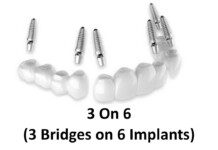
In today’s fast-paced world, convenience is paramount. With just a few taps on a smartphone, we can order groceries, get virtual decorating advice, schedule appointments, take online courses, and so much more. The allure of instant solutions permeates every aspect of our life, including healthcare. However, in dentistry, the complexities and variables involved demand a nuanced approach extending beyond the comprehension of the average person. While the temptation to provide treatment plans remotely may seem convenient, it’s essential to recognize the limitations imposed by the public’s limited understanding of dentistry.
Patients often unknowingly articulate their concerns ineffectively, relying on vague descriptors or self-diagnoses based on internet research: often unreliable and misleading. Many times, patients will present for one treatment protocol only to find they need something entirely different than they thought. Or that they don’t even qualify for the treatment they WANT.
The Importance of In-Person Evaluation in Dental Treatment Planning
Dental professionals rely on visual inspections, palpation, and diagnostic tests such as X-rays to detect subtle abnormalities and assess oral health comprehensively. Without these essential components, providing accurate treatment recommendations becomes akin to solving a puzzle with missing pieces—potentially leading to incomplete or inaccurate conclusions. And understandingly, frustrated patients.
Fully Understanding Your Needs
Dental literacy, or lack thereof, significantly influences how patients perceive and articulate their needs. Studies have consistently shown that the average person possesses minimal knowledge about dental anatomy, oral pathology, and treatment modalities. Terms like “caries,” “periodontitis,” or “occlusal abnormalities” may elicit confusion rather than comprehension in most individuals.
This knowledge gap extends to the recognition and interpretation of dental symptoms. While some conditions manifest as obvious pain or visible abnormalities, others may go unnoticed by patients until they escalate into more severe problems. Consequently, patients may downplay or misinterpret their symptoms, inadvertently omitting crucial information necessary for accurate diagnosis and treatment planning.
Another common issue is that patients often think they need something other than they do. They read things online and think, “yeah. That sounds like me. I bet that’s what I need!” Verbal descriptions of treatments being sought often differ from what a patient actually needs or is picturing in their mind. They simply use the wrong words or give an incomplete answer, completely unaware they’re doing so.
In many cases, when patients call inquiring about a treatment, what they really want is a cost estimate. However, due to the diverse range of treatments we offer and the numerous variables associated with each, it’s not feasible to provide a straightforward fee quote.
When it comes to dental care, there’s a crucial aspect that cannot be overlooked. That is the necessity of an in-person, oral evaluation before devising a treatment plan. There is plenty of information available at our fingertips online. As helpful as this may be in helping us understand various available options, dental treatment is not one-size-fits-all. Each patient presents with unique oral anatomy, medical history, cosmetic and oral health concerns. Attempting to formulate a treatment plan without physically examining a patient poses significant risks and limitations.
Why a treatment plan and fee cannot be accurately provided to a new patient over the phone:
Limited Assessment: Over-the-phone consultations lack the depth and precision of an in-person examination. A comprehensive dental evaluation involves assessing the condition of the teeth, gums, oral tissues, and jaw alignment. Visual inspections, palpation, and diagnostic tests such as X-rays are indispensable for identifying issues that may not be apparent through verbal descriptions alone.
Incomplete Information: Patients may not accurately convey their dental concerns or may overlook symptoms that are critical for diagnosis. Subtle signs of dental problems, such as early-stage decay or gum disease, can be easily missed during a phone conversation. Additionally, underlying health conditions and medications can influence oral health, necessitating a thorough review of the patient’s medical history.
Risk of Misdiagnosis: Without a thorough examination, there is a heightened risk of misdiagnosis or overlooking underlying issues. What may seem like a minor cosmetic concern over the phone could be indicative of a more serious underlying dental problem requiring immediate attention. Providing treatment recommendations without proper evaluation may lead to inappropriate or ineffective interventions, potentially exacerbating the patient’s condition.
Patient Expectations: Offering treatment plans without assessing a patient’s diagnostic criteria can create unrealistic expectations. Patients may anticipate a certain treatment based on their description of symptoms, only to find that their actual dental needs differ significantly upon examination. This mismatch between expectations and reality can lead to dissatisfaction and erode trust in the dental provider.
Legal and Ethical Considerations: Dentistry is governed by strict ethical standards and legal regulations aimed at ensuring patient safety and quality of care. Providing treatment recommendations without a comprehensive evaluation may violate professional standards and expose dental practitioners to legal liabilities in the event of adverse outcomes.
Are There Any Exceptions?
Yes. A Zoom consultation with the doctor (not staff). In order to give any advice, the doctor needs a complete medical history and current radiographs. A panoramic x-ray (and/or a CBCT scan) is necessary to evaluate the underlying bone structures. He also needs to see the current condition of any remaining teeth and/or dental work. This can be seen in the x-ray and CBCT scan. Luckily, these diagnostic images can usually be emailed or mailed to us on a disc, saving out-of-town patients an initial trip.
This (Zoom call consultation) can only be done for patients who have been pre-screened for certain treatments. The most common one being a full mouth dental implant treatment. This is different than answering the phone and trying to decipher what a patient has or doesn’t have in their mouth solely by their description, (which is often inaccurate.) Full mouth treatments are different because they’re either already missing all their teeth or they expect they will need to have them all removed. Full mouth dental implant cases typically have that specificity in common.
So, we gather and review a lot of information prior to the Zoom call. We have already established that these patients are seeking a specific end goal” They all either have no teeth or expect to have no teeth as their baseline. They know they want to replace a full mouth of teeth. This was established this in advance. We’ve received and reviewed their medical history, their x-rays and often, photographs.
From this starting point, there are often several options available. But not all patients have the luxury of just picking any treatment they WANT. The x-rays are crucial in helping the doctor to make baseline judgments and make recommendations as to which options ARE or ARE NOT possible for a given patient. The treatment options, timelines and fees can vary by tens of thousands of dollars. These conversations do not all go the same way. This is where the face to face, (Zoom) video call differs from a telephone call. The doctor is able to see the patient’s face and profile, the size and shape of their head and teeth. He can evaluate how they speak, and discuss what they do or don’t like about the esthetics of their teeth and what can and can’t be done to address those concerns. NOW, we can answer some questions!
Conclusion
While technology has transformed many aspects of healthcare delivery, there are inherent limitations to providing dental treatment plans over the phone without an in-person evaluation. The complexities of oral health require a personalized approach that considers the unique needs and circumstances of each patient. By prioritizing thorough examinations and in-person consultations, dental professionals can deliver safe, effective, and patient-centered care that optimizes oral health outcomes.
In conclusion, the intricacies of dentistry extend far beyond the layperson’s understanding, highlighting the indispensable role of in-person evaluation in treatment planning. By acknowledging the knowledge gap and embracing a patient-centered approach, we can better navigate these conversations. We can address the complexities of discussing individualized treatment needs with precision and empathy, ultimately fostering better outcomes and enhancing patient satisfaction and trust.
Dental treatments are not one size fits all. Offices who can tell you what you need to pay without seeing you should be avoided. They are likely overcharging you by adding fees to every case as a line item to make money. What one person needs isn’t always what the next will need. You wouldn’t expect your cardiovascular surgeon to tell you what you need over the phone – or even your plumber. Why would you think a dentist is any different? We need to see you first. Or, at the very least, x-rays and a medical history. It’s as simple as that.
With that in mind, we don’t think it’s right to charge people to answer their cost questions, so we offer that consultation at no charge. X-rays included. We want to be sure you fully understand your current condition. That you know ALL your available options, and have answers to ALL your questions before deciding on a treatment plan.
[/vc_column_text][/vc_column][/vc_row]






